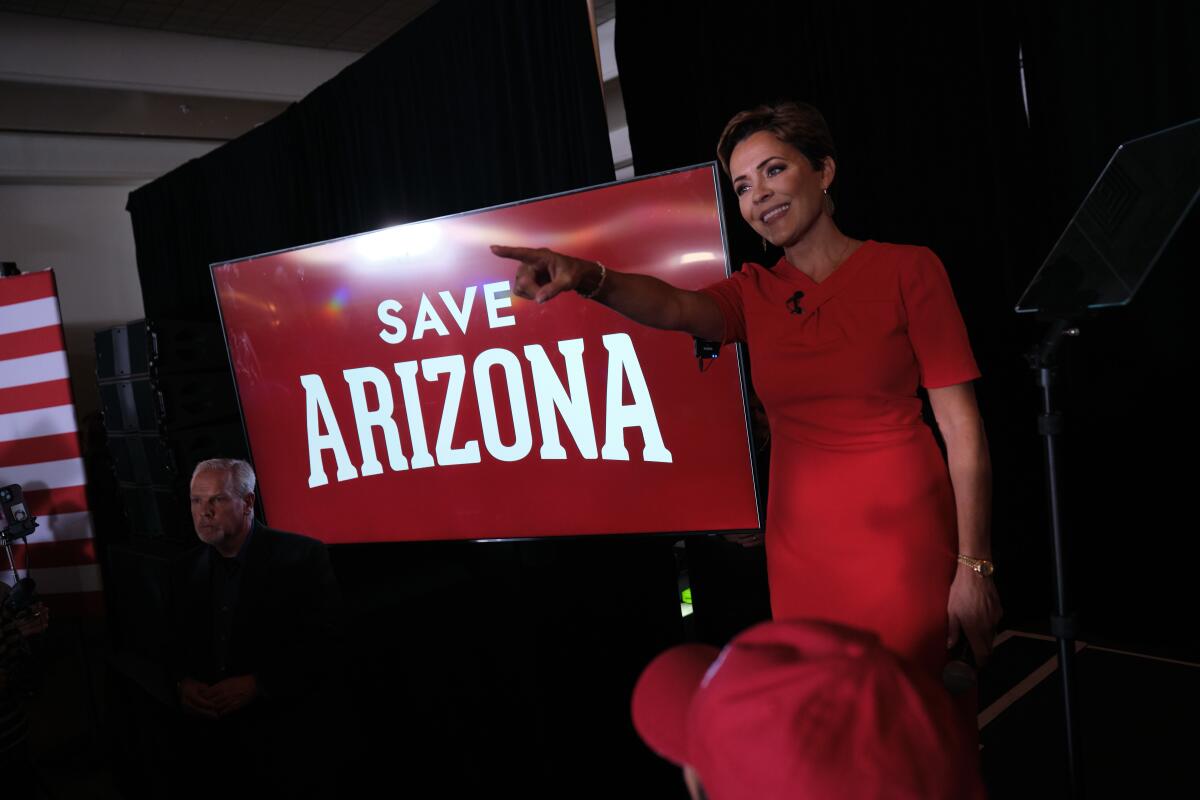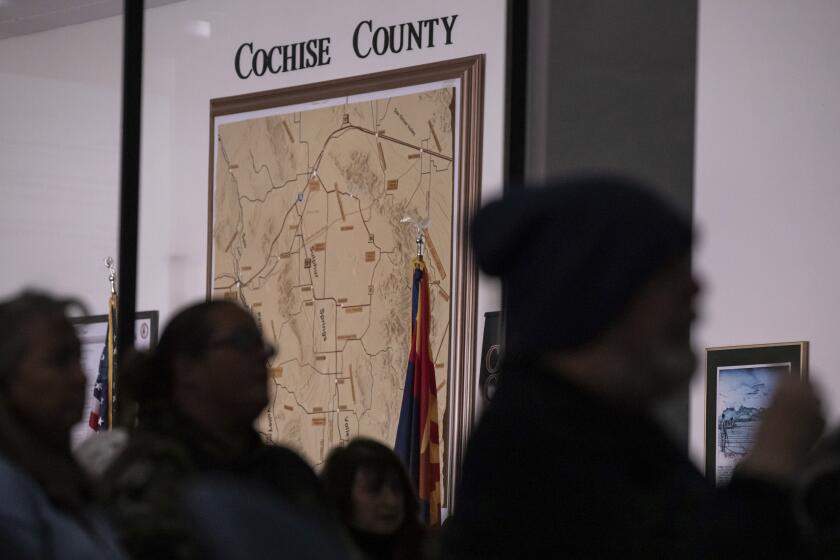Opinion: Reality deniers like Kari Lake fit right in with Arizona’s history of wishful thinking

Kari Lake isn’t giving up. Even as she prepares to mount a campaign for U.S. senator, and more than two months after her opponent was sworn in as Arizona’s governor, she insists that she won the governor’s race and that the election was stolen.
Election denial has become one of the pillars of the modern GOP — but the desert soil of Arizona soaks up such hallucinatory claims like rain, at least partly because of the state’s unique history. Through most of the last century and a half, Arizona has been a geography of personal reinvention, ambitious schemes and glowing hype that exceeded nature’s limits. The name itself is derived from a 1736 silver rush in a valley near a ranch called “Arizona” that flamed out just weeks after it began. Lake’s false crusade has already lasted longer.
What’s in the water in Arizona that inspires such obvious flimflammery?
In Arizona, the bedrock issue of free and fair elections is on the ballot as Trump acolytes vie to seize the state’s election machinery.
Well, for starters, what water? A make-believe approach toward hydrology has characterized Arizona’s modern development. A state with an average annual rainfall of just 12 inches grows tens of thousands of acres of high-moisture cotton and supports more than 370 golf courses, in addition to 2.6 million households. Its allotment from the Colorado River was based on wildly optimistic flow projections a century ago. By the 1960s, the state had to build a 330-mile canal to push water uphill, away from its great rival California. A lengthy drought and falling levels in Lake Powell, the country’s second-biggest reservoir, are now throwing future real estate ventures and population growth into doubt.
Fecklessness with limited water is practically written into Arizona’s DNA. In 1912, federal money put what was then the world’s biggest dam on the Salt River, and the farmer-aristocrats in the new state legislature thought so much of it they put its image on the official state seal.
Election losses by GOP candidates last year who denied the legitimacy of the 2020 presidential results have added fuel to conspiracy theories in rural Arizona.
But their exuberance over the new Eden in the desert — they thought the land hid mammoth springs beneath its surface — was overblown. “Underground waters were believed to be virtually inexhaustible,” said a 1949 Bureau of Reclamation report, published after most of Arizona’s surface water had been exhausted. “People held firm to the concept of vast underground rivers pouring endlessly to the sea and proceeded to develop more land.”
Land didn’t even need to be improved much to be a hot commodity in the state’s thunderdome of wishful thinking. During the 1960s, shady real estate brokers treated Arizona like a dry Florida with cactus, with homesites of worthless scrub sold to buyers through the mail via glitzy magazine advertisements, sight unseen. Dupes were horrified when they showed up in person to see barren lots, in the middle of nowhere, without utilities.
Big land hustles like Golden Valley, Prescott Valley and Rio Rico — stretches of wasteland that a previous generation of ranchers had valued at just pennies on the acre — gave the state a dirty reputation nationwide. But gullible buyers always played a key role in settling Arizona. One famous scoundrel, James Reavis, “The Baron of Arizona,” managed in the 1880s to convince hundreds of landowners between Phoenix and Silver City, N.M., to pay him quitclaim fees on land he didn’t own. He told them he was heir to a huge 18th century land grant from Charles III of Spain. Never mind that the supposed grant was written on paper bearing the watermark of a Wisconsin mill. Reavis made a fortune.
Law: Federal jury finds Fife Symington lied to lenders in order to save his real estate empire. He is state’s second chief to be ousted from office in less than a decade.
Nineteenth-century promoters touted dozens of Arizona mining settlements as the next Chicago or Pittsburgh. John Clum, the founding editor of the state’s oldest continuously published newspaper, the Tombstone Epitaph, described that gang-infested town as “a city set upon a hill, promising to vie with ancient Rome, in a fame different in character but no less in importance.”
Arizonans see what they choose to see. Before he went to federal prison in 1992, savings and loan king Charles Keating built a gilded luxury resort here called the Phoenician, with money filched from the savings of thousands of small depositors. During the 1964 presidential race, Sen. Barry Goldwater suggested he would defoliate the tree cover over the Ho Chi Minh Trail with nuclear weapons — and for good measure, he would “lob one into the men’s room at the Kremlin” too. It helped cost him the general election, but Arizonans loved it.
A lack of rootedness doesn’t help defend against outlandish fantasies. Nearly 60% of Arizona’s current residents weren’t born here. The real estate economy functions like a Ponzi scheme in that sense, requiring a constant stream of buyers from elsewhere to justify the endless expansion of stucco roofs to the desert horizons. This is still the fastest-growing state in the West, with a 1.3% population uptick since 2021.
Part of the Arizona Dream is that you can move here with no family connections and no history and fit right in — even be elected to high office. People migrate here for a second chance and a fresh start in the land of wide-open skies and new opportunities.
Without question, those exist, as does the knowledge, pragmatism, natural beauty and neighborly character that gives Arizona enduring appeal. But charlatans still hide in the sunshine. Harvard University’s Edmond J. Safra Center for Ethics surveyed reporters in 2014 and named Arizona the most corrupt state in the country.
Some might see a change in Arizona’s psyche, with its leftward tilt, electing a Democratic governor, throwing its electoral votes to Joe Biden, and shifting the political gravity away from clowns like Sheriff Joe Arpaio. But the Legislature remains in the hands of those who yelled “election fraud,” while their donors keep writing checks. Those wishing for a clean fade from red to blue are also chasing rainbows.
Tom Zoellner, a fifth-generation Arizonan, is the author of the new book “Rim to River: Looking Into the Heart of Arizona.” This article was produced in partnership with Zócalo Public Square.
More to Read
A cure for the common opinion
Get thought-provoking perspectives with our weekly newsletter.
You may occasionally receive promotional content from the Los Angeles Times.












